Optimization and Experiment of Livestock and Poultry Manure Composting Equipment with Vented Heating
Abstract
1. Introduction
2. Experiments and Methods
2.1. Overall Structure and Workflow of the Equipment
2.1.1. 3D Model of Composting Equipment
2.1.2. Working Process
2.2. Structural Optimization of Ventilation Heating System
2.3. Optimization of Mixing Blades
2.4. Optimization of Control Part
2.5. Experimental Verification of the Practicality of Composting Equipment
3. Result and Analysis
3.1. Temperature Changes in Composting
3.2. PH Value Changes in Composting
3.3. Oxygen Concentration Changes in Composting
3.4. Humidity Changes in Composting
3.5. Seed Germination Index Changes in Composting
3.6. Comparison of Test Results and Evaluation of Equipment Practicality
4. Discussion
5. Conclusions
- Enhancements in the mixing structure, ventilation and heating system, and automation level greatly contribute to the overall efficiency of the composting process. These improvements could potentially have a significant impact on agricultural sustainability and address challenges related to livestock manure management.
- The seed germination index (GI) value of the organic fertilizer produced using the improved equipment has increased from 81% to 89%, suggesting a higher maturity level and less potential harm to crops. The pH value remains within the industry standard of 5.5–8.5, recorded specifically at 6.6. The minimum stacking humidity has been reduced slightly from 8.9% to 8.1%, still well within the acceptable industry standard of less than 30%.
- The modified composting equipment successfully maintained the high-temperature duration of the composting material for a period of 7 days, complying with industry regulations.
Author Contributions
Funding
Institutional Review Board Statement
Informed Consent Statement
Data Availability Statement
Conflicts of Interest
Abbreviations
| MCGS | Monitor and Control Generated System |
| PLC | Programmable logic Controller |
| °C | Anders Celsius |
| kJ | Kilojoules |
| h | hour |
| K | Kelvins |
| m3 | cubic meter |
| mm | millimeter. |
| W | Watt |
| GI | Germination index |
| PH | Potential of hydrogen |
| Heat released by the electric heating tube | |
| The heat absorbed by the air pump during heating | |
| Heat conduction on the wall of the heating box | |
| Heat absorbed by water evaporation in the air | |
| Other forms of heat loss | |
| Specific heat capacity of air | |
| Air density | |
| Ventilation capacity | |
| Air temperature change value | |
| Air thermal conductivity | |
| Contact area | |
| Temperature difference between objects | |
| Heat transfer distance | |
| Net mass of water vapor in the air | |
| Enthalpy value of water vapor |
References
- Awasthi, M.K.; Singh, E.; Binod, P.; Sindhu, R.; Sarsaiya, S.; Kumar, A.; Chen, H.; Duan, Y.; Pandey, A.; Kumar, S.; et al. Biotechnological strategies for bio-transforming biosolid into resources toward circular bio-economy: A review. Renew. Sustain. Energy Rev. 2022, 156, 111987. [Google Scholar] [CrossRef]
- Romano, E.; Brambilla, M.; Bisaglia, C.; Assirelli, A. Using Image Texture Analysis to Evaluate Soil–Compost Mechanical Mixing in Organic Farms. Agriculture 2023, 13, 1113. [Google Scholar] [CrossRef]
- Zhou, H.; Di, L.; Hua, X.; Deng, T.; Wang, X. The Addition of a Small Dose of Cinnamomum camphora Biomass Unexpectedly Enhanced Lignocellulose Degradation during the Compost of Stropharia rugosoannulata Cultivation Materials. Sustainability 2023, 15, 10483. [Google Scholar] [CrossRef]
- Li, D.; Qi, C.; Wei, Y.; Li, G. Measurement of pollution production coefficient of sheep breeding industry in Northern China. Trans. Chin. Soc. Agric. Eng. 2021, 37, 220–227. [Google Scholar]
- Gottschall, R.; Thelen-Jüngling, M.; Kranert, M.; Kehres, B. Suitability of Biowaste and Green Waste Composts for Organic Farming in Germany and the Resulting Utilization Potentials. Agriculture 2023, 13, 740. [Google Scholar] [CrossRef]
- Zhen, X.; Tan, C.; Li, Z.; Lin, Z.; Zhang, Y.; Kang, J. Humus Transformation and Compost Maturity Indexes in High-Temperature Composting of Livestock and Poultry Manure. J. Biobased Mater. Bioenergy 2022, 16, 329–335. [Google Scholar] [CrossRef]
- Wang, Q.; Awasthi, M.K.; Zhao, J.; Ren, X.; Li, R.; Wang, Z.; Wang, M.; Zhang, Z. Improvement of pig manure compost lignocellulose degradation, organic matter humification and compost quality with medical stone. Bioresour. Technol. 2017, 243, 771–777. [Google Scholar] [CrossRef] [PubMed]
- Agegnehu, G.; Bass, A.M.; Nelson, P.N.; Muirhead, B.; Wright, G.; Bird, M.I. Biochar and biochar-compost as soil amendments: Effects on peanut yield, soil properties and greenhouse gas emissions in tropical North Queensland, Australia. Agric. Ecosyst. Environ. 2015, 213, 72–85. [Google Scholar] [CrossRef]
- Awasthi, M.K.; Pandey, A.K.; Bundela, P.S.; Wong, J.W.C.; Li, R.; Zhang, Z. Co-composting of gelatin industry sludge combined with organic fraction of municipal solid waste and poultry waste employing zeolite mixed with enriched nitrifying bacterial consortium. Bioresour. Technol. 2016, 213, 181–189. [Google Scholar] [CrossRef]
- Huo, L.; Zhao, L.; Meng, H.; Yao, Z. Study on straw multi-use potential in China. Trans. Chin. Soc. Agric. Eng. 2019, 35, 218–224. [Google Scholar]
- Sobieraj, K.; Stegenta-Dąbrowska, S.; Zafiu, C.; Binner, E.; Białowiec, A. Carbon Monoxide Production during Bio-Waste Composting under Different Temperature and Aeration Regimes. Materials 2023, 16, 4551. [Google Scholar] [CrossRef]
- Sobieraj, K.; Stegenta-Dąbrowska, S.; Luo, G.; Koziel, J.A.; Białowiec, A. Biological treatment of biowaste as an innovative source of CO—The role of composting process. Front. Bioeng. Biotechnol. 2023, 11, 1126737. [Google Scholar] [CrossRef]
- Stegenta-Dąbrowska, S.; Drabczyński, G.; Sobieraj, K.; Koziel, J.A.; Białowiec, A. The Biotic and Abiotic Carbon Monoxide Formation during Aerobic Co-digestion of Dairy Cattle Manure with Green Waste and Sawdust. Front. Bioeng. Biotechnol. 2019, 7, 283. [Google Scholar] [CrossRef] [PubMed]
- Lu, Y.; Chadwick, D.; Norse, D.; Powlson, D.; Shi, W. Sustainable intensification of China’s agriculture: The key role of nutrient management and climate change mitigation and adaptation. Agric. Ecosyst. Environ. 2015, 209, 1–4. [Google Scholar] [CrossRef]
- Gilbert, J.; Siebert, S. ECN Data Report 2022. Compost and Digestate for a Circular Bioeconomy. Overview of Bio-Waste Collection, Treatment & Markets Across Europe; European Compost Network ECN e.V: Bochum, Germany, 2022. [Google Scholar]
- Shrestha, P.P.; Ghimire, A.; Dangi, M.B.; Urynowicz, M.A. Development of a Municipal Solid Waste Management Life Cycle Assessment Tool for Banepa Municipality, Nepal. Sustainability 2023, 15, 9954. [Google Scholar] [CrossRef]
- Liu, H. Analysis on the Behavior of Farmers of Returning Manure to Fields and Its Influencing Factors in Jilin Province. Master’s Thesis, Jilin Agricultural University, Changchun, China, 2022. [Google Scholar]
- Wang, M.Z. Study on Optimization of Technical Parameters of Sheep Manure Aerobic Composting. Master’s Thesis, Nanjing Agricultural University, Nanjing, China, 2022. [Google Scholar]
- Ming, L.; Dou, S.; Wang, H.; Zhu, Y. Study of the Humification Process and Humic Acid-like Structure Characteristics of Kitchen Waste with the Addition of Biochar. Agronomy 2023, 13, 465. [Google Scholar] [CrossRef]
- Wang, R.; Ren, T.; Feng, L.; Wang, T.; Wang, T. Prediction of the Moisture Content in Corn Straw Compost Based on Their Dielectric Properties. Appl. Sci. 2023, 13, 917. [Google Scholar] [CrossRef]
- Shyan, L.L.; Mat Nanyan, N.S.; Ismail, N.; Al-Gheethi, A.; T. Nguyen, H.-H.; Vo, D.-V.N.; El Enshasy, H.A. Effort to Mitigate Volatile Fatty Acid Inhibition by Using Mixed Inoculum and Compost for the Degradation of Food Waste and the Production of Biogas. Sustainability 2023, 15, 1185. [Google Scholar] [CrossRef]
- Makan, A.; Fadili, A.; Oubenali, M. Interaction of physicochemical parameters during pressurized in-vessel composting of food waste. Bioresour. Technol. Rep. 2020, 10, 100350. [Google Scholar] [CrossRef]
- Xiong, J.; Ma, S.; He, X.; Han, L.; Huang, G. Nitrogen transformation and dynamic changes in related functional genes during functional-membrane covered aerobic composting. Bioresour. Technol. 2021, 332, 125087. [Google Scholar] [CrossRef]
- Schneider, J.; Burg, J.M.; Theilen, U.; Weigand, H.; Brück, F. Towards optimized drum composting: Evaluation of the radial mixing performance of a model substrate on the laboratory scale. Environ. Technol. 2020, 41, 1606–1613. [Google Scholar] [CrossRef]
- Yang, Y.; Liang, W.; Hu, K. Simulated Ammonia Nitrogen Wastewater Treated with Spent Mushroom Compost in a Laboratory Bioreactor. Pol. J. Environ. Stud. 2016, 25, 2197–2203. [Google Scholar] [CrossRef]
- Jain, M.S.S.; Paul, A.S.; Kalamdhad, A.S. Kinetics and physics during composting of various organic wastes: Statistical approach to interpret compost application feasibility. J. Clean. Prod. 2020, 255, 120324. [Google Scholar] [CrossRef]
- Yu, P.; Chen, J.X. Performance test on the composting process of food wastes in a small composting reactor. Journal of Hunan Agricultural University. Nat. Sci. 2021, 47, 351–355. [Google Scholar]
- Li, S.; Dang, Y.Q.; Tang, F.B.; Meng, Y.J. Optimization research on evaluation index of aerobic compost based on ventilation frequency control. Soil Fertil. Sci. China 2020, 3, 182–188. [Google Scholar]
- Yan, C.; Cao, L.; Liu, Y.; Ruan, R.; NIing, W.; Liu, X.; Li, R. Effect of new high temperature aerobic composting device on maturation of chicken manure and rice chaff. Chin. J. Environ. Eng. 2021, 15, 1103–1111. [Google Scholar]
- Onwosi, C.O.; Igbokwe, V.C.; Odimba, J.N.; Eke, I.E.; Nwankwoala, M.O.; Iroh, I.N.; Ezeogu, L.I. Composting technology in waste stabilization: On the methods, challenges and future prospects. J. Environ. Manag. 2017, 190, 140–157. [Google Scholar] [CrossRef] [PubMed]
- Scaglia, B.; Orzi, V.; Artola, A.; Font, X.; Davoli, E.; Sanchez, A.; Adani, F. Odours and volatile organic compounds emitted from municipal solid waste at different stage of decomposition and relationship with biological stability. Bioresour. Technol. 2011, 102, 4638–4645. [Google Scholar] [CrossRef] [PubMed]
- Wang, F. Design and Experiment of Small Composting Equipment for Fecal Matter of Livestock and Poultry Based on Heating by Aeration. Master’s Thesis, Inner Mongolia Agricultural University, Hohhot, China, 2021. [Google Scholar]
- Alkoaik, F.N.; Abdel-Ghany, A.M.; Rashwan, M.A.; Fulleros, R.B.; Ibrahim, M.N. Energy Analysis of a Rotary Drum Bioreactor for Composting Tomato Plant Residues. Energies 2018, 11, 449. [Google Scholar] [CrossRef]
- Komolafe, A.F.; Adejuyigbe, C.O.; Babalola, O.A. Fertilizer values of composts as affected by plant materials and composting duration on maize (Zea mays) performance. Agro-Science 2021, 20, 87–94. [Google Scholar] [CrossRef]
- Siswati, L.; Nizar, R.; Ariyanto, A. Manfaatkan Kotoran Sapi Menjadi Kompos Untuk Tanaman Masa Pandemi Di Kelurahan Umbansari Kota Pekanbaru. Din. J. Pengabdi. Kpd. Masy. 2021, 5, 531–537. [Google Scholar] [CrossRef]
- Lohr, D.; Gruda, N.S.; Meinken, E. Estimating Nitrogen Release from Organic Fertilizers for Soilless Production by Analysis of C and N Pools. Horticulturae 2023, 9, 767. [Google Scholar] [CrossRef]
- Zhou, P.X. Research of Enhancing Compost Maturity of Sewage Sludge by Hyperthermophilic Aerobic Fermentation Technology. Master’s Thesis, Fujian Agricultural University, Fuzhou, China, 2018. [Google Scholar]
- Singh, Y.P.; Arora, S.; Mishra, V.K.; Singh, A. Composting of Municipal Solid Waste Using Earthworms and Ligno-Cellulolytic Microbial Consortia for Reclamation of the Degraded Sodic Soils and Harnessing Their Productivity Potential. Sustainability 2023, 15, 2317. [Google Scholar] [CrossRef]
- Cai, J. Dynamics of Maggots and Manure Based on DEM and Optimal Design of the Multi-Dimensional Sieving Machine. Master’s Thesis, Jiangsu University, Zhenjiang, China, 2018. [Google Scholar]
- Rozas, A.; Aponte, H.; Maldonado, C.; Contreras-Soto, R.; Medina, J.; Rojas, C. Evaluation of Compost and Biochar as Partial Substitutes of Peat in Growing Media and Their Influence in Microbial Counts, Enzyme Activity and Lactuca sativa L. Seedling Growth. Horticulturae 2023, 9, 168. [Google Scholar] [CrossRef]
- Ahsan, W.A.; Hussain, A.; Lin, C.; Nguyen, M.K. Biodegradation of Different Types of Bioplastics through Composting—A Recent Trend in Green Recycling. Catalysts 2023, 13, 294. [Google Scholar] [CrossRef]
- Stewart, S. Efficacy of organic amendments used in containerized plant production: Part 1–Compost-based amendments. Sci. Hortic. 2020, 266, 108856. [Google Scholar] [CrossRef]
- Gaudutis, A.; Jotautienė, E.; Mieldažys, R.; Bivainis, V.; Jasinskas, A. Sustainable Use of Biochar, Poultry and Cattle Manure for the Production of Organic Granular Fertilizers. Agronomy 2023, 13, 1426. [Google Scholar] [CrossRef]
- Antonious, G.F.; Turley, E.T.; Gyawali, B.R.; Freeman, A.C. Influence of Biochar and Animal Manures Application on Ammonia and Nitrate Concentrations in the Root and Shoot of Three Varieties of Turnips. Agriculture 2023, 13, 137. [Google Scholar] [CrossRef]
- Soliman, Y.M.; Soliman, W.S.; Abbas, A.M. Alley Cropping and Organic Compost: An Efficient and Sustainable Agro-Ecological Strategy for Improving Turmeric (Curcuma longa L.) Growth and Attributes. Agriculture 2023, 13, 149. [Google Scholar] [CrossRef]
- Tong, Z.; Liu, F.; Rajagopalan, U.M.; Sun, B.; Tian, Y.; Zuo, Q.; Zhang, J.; Duan, J.; Bi, W.; Qin, J.; et al. Effect of Biochar-Containing Compost on Cucumber Quality and Antibiotic Resistance Genes Abundance in Soil–Cucumber System. Sustainability 2023, 15, 9563. [Google Scholar] [CrossRef]
- Rehman, S.U.; De Castro, F.; Marini, P.; Aprile, A.; Benedetti, M.; Fanizzi, F.P. Vermibiochar: A Novel Approach for Reducing the Environmental Impact of Heavy Metals Contamination in Agricultural Land. Sustainability 2023, 15, 9380. [Google Scholar] [CrossRef]
- Liu, L.; Li, J.; Wu, G.; Shen, H.; Fu, G.; Wang, Y. Combined effects of biochar and chicken manure on maize (Zea mays L.) growth, lead uptake and soil enzyme activities under lead stress. PeerJ 2021, 9, e11754. [Google Scholar] [CrossRef] [PubMed]
- Banik, C.; Koziel, J.A.; De, M.; Bonds, D.; Chen, B.; Singh, A.; Licht, M.A. Biochar-Swine Manure Impact on Soil Nutrients and Carbon under Controlled Leaching Experiment Using a Midwestern Mollisols. Front. Environ. Sci. 2021, 9, 609621. [Google Scholar] [CrossRef]
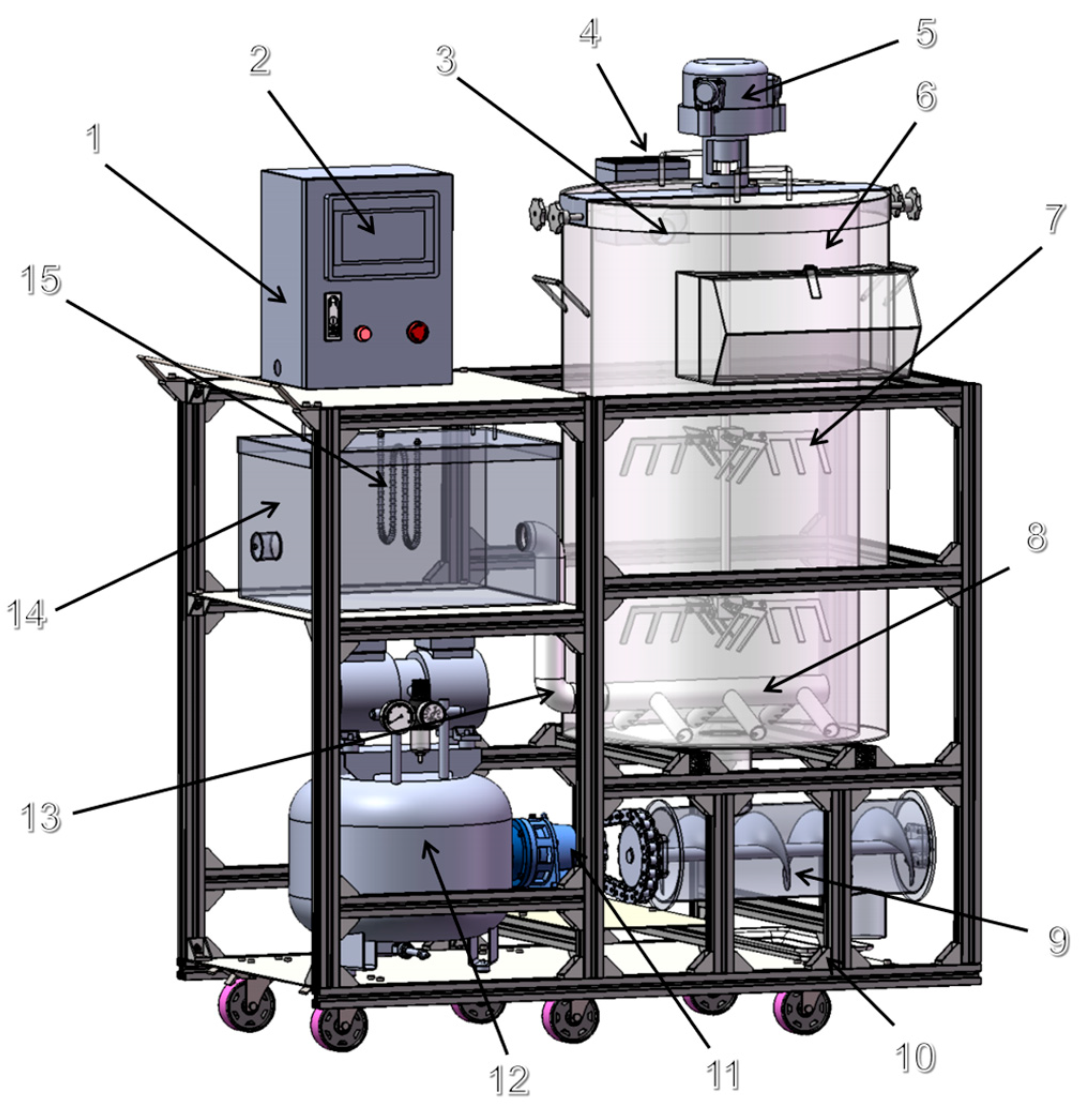
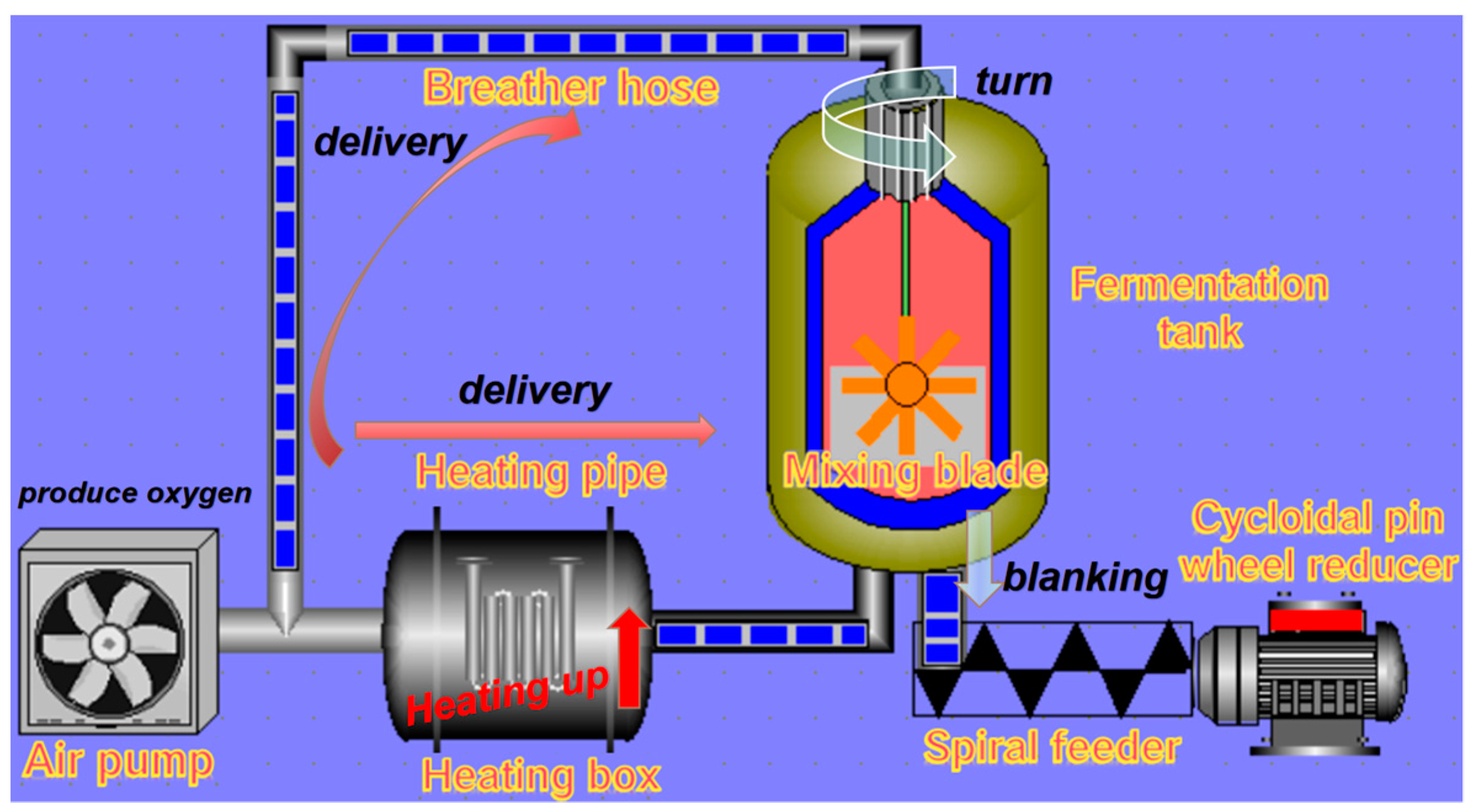
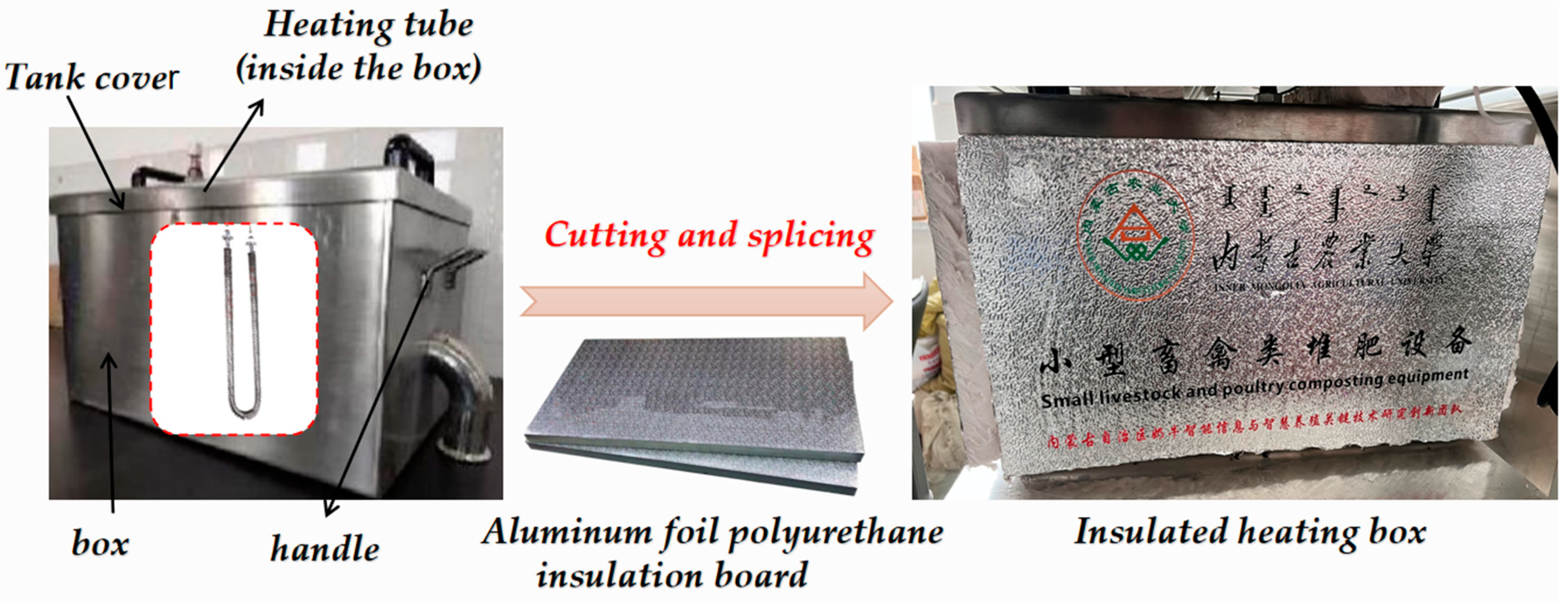

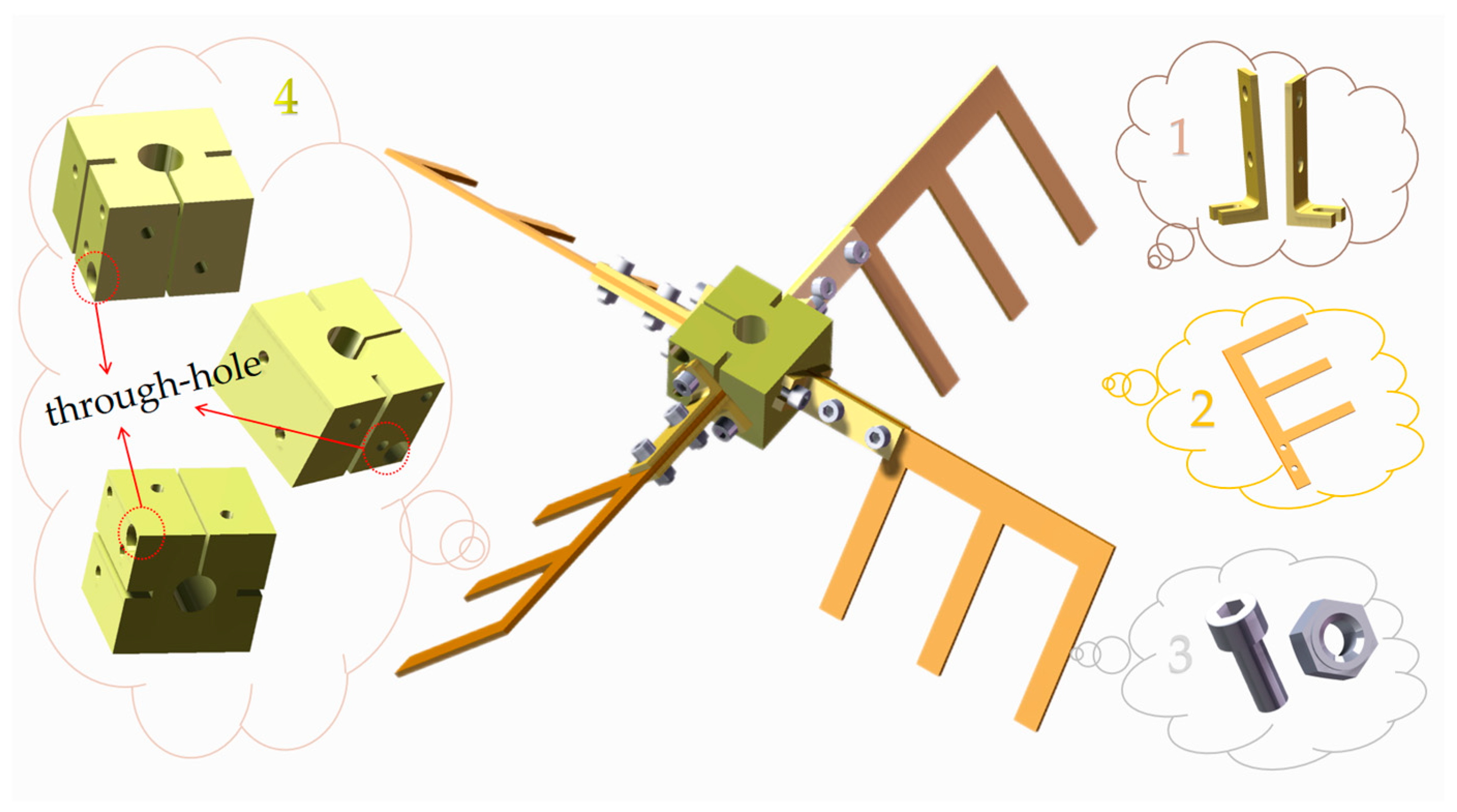

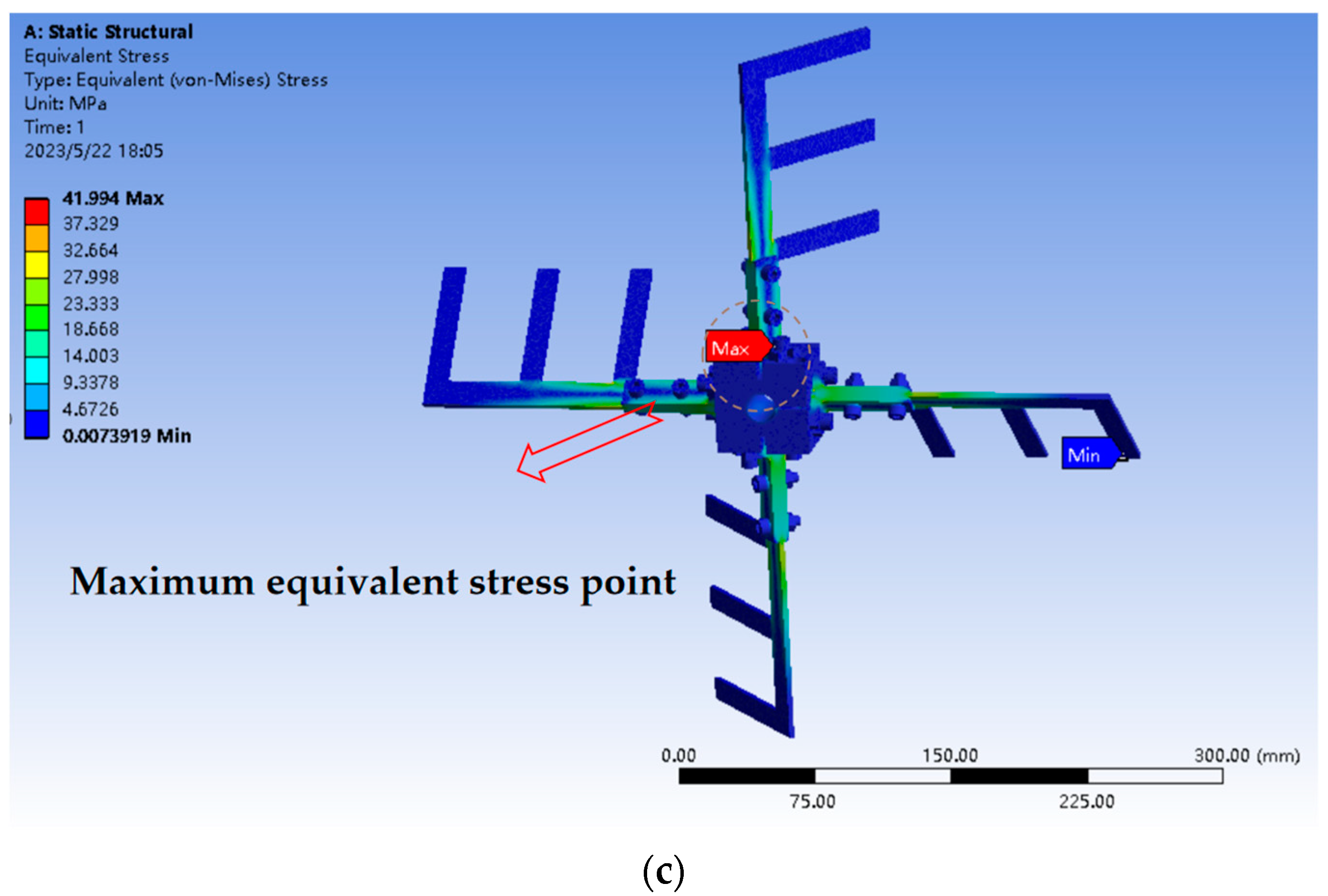

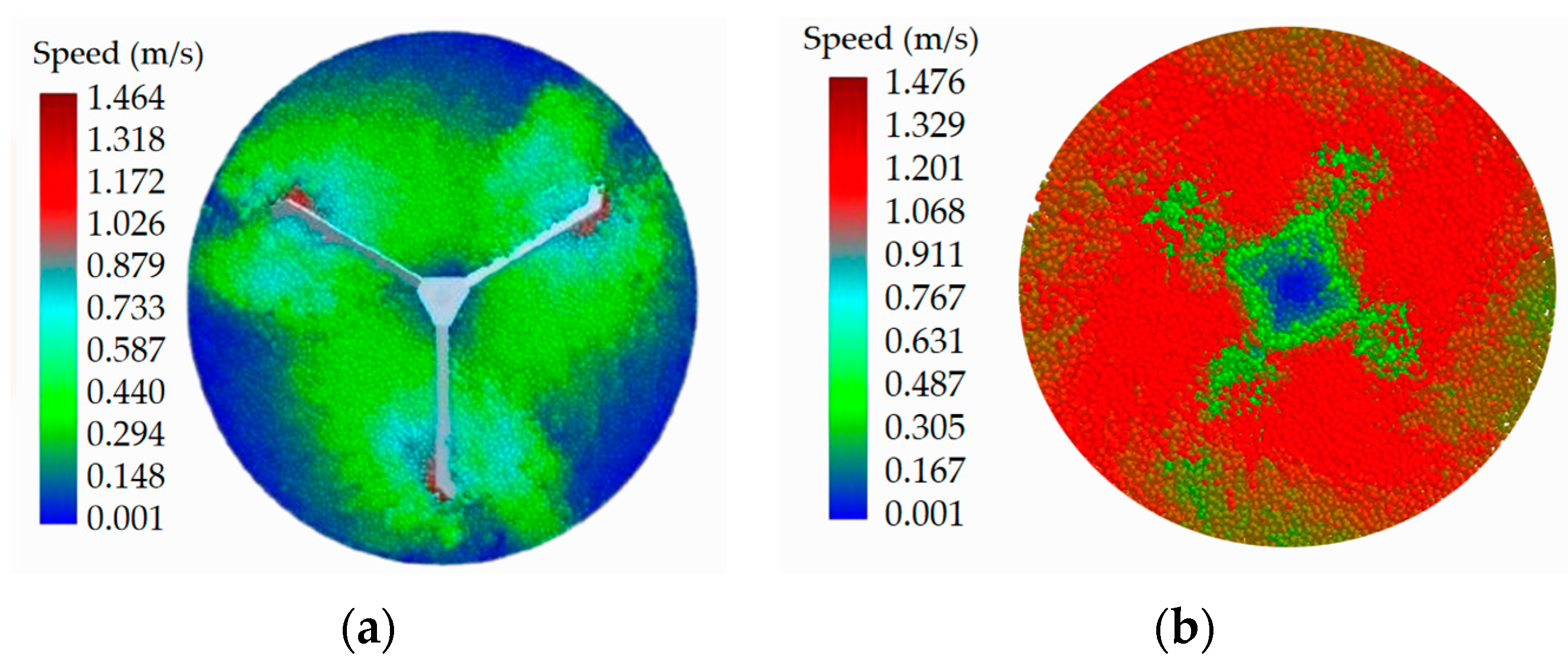

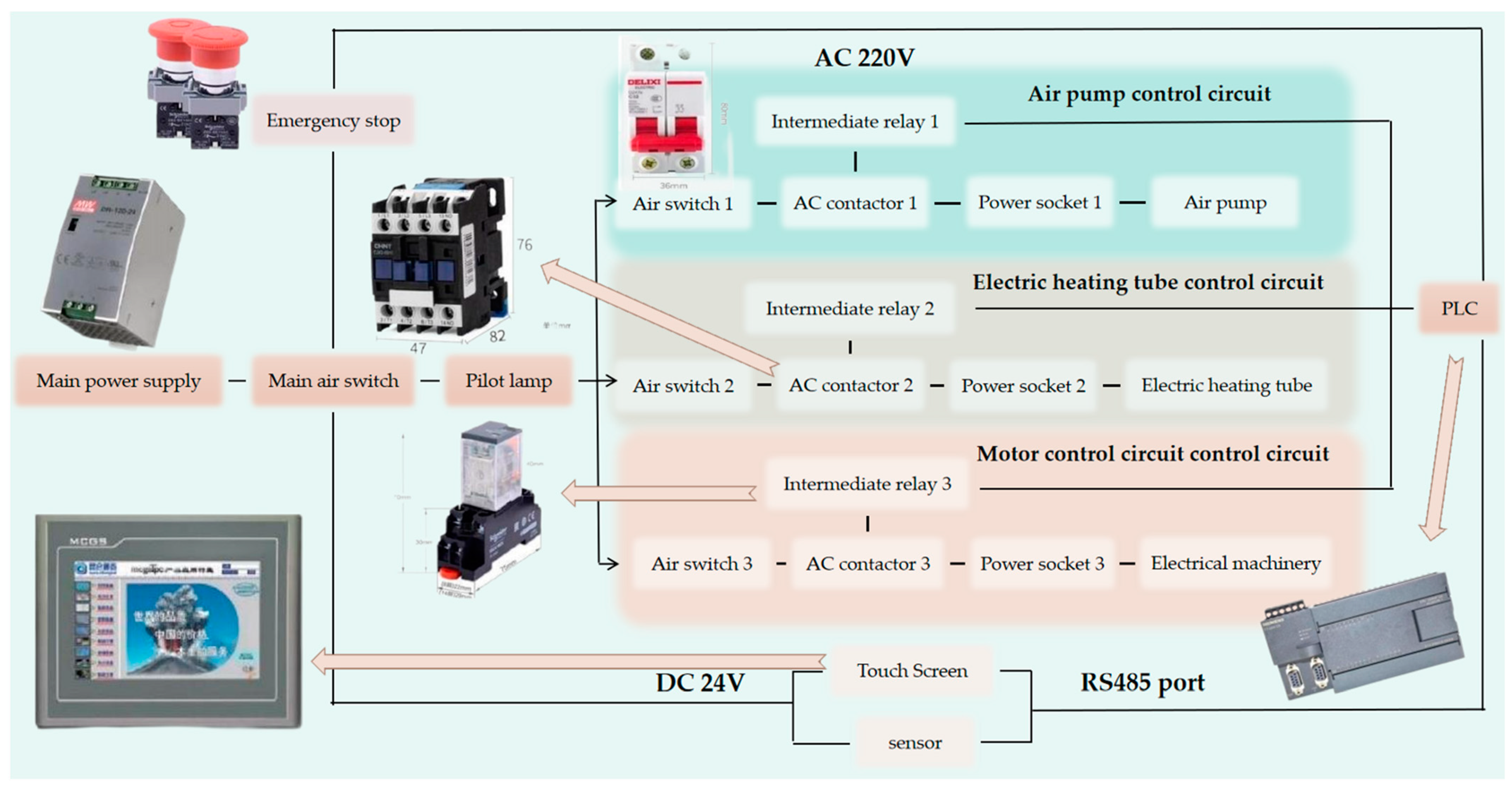
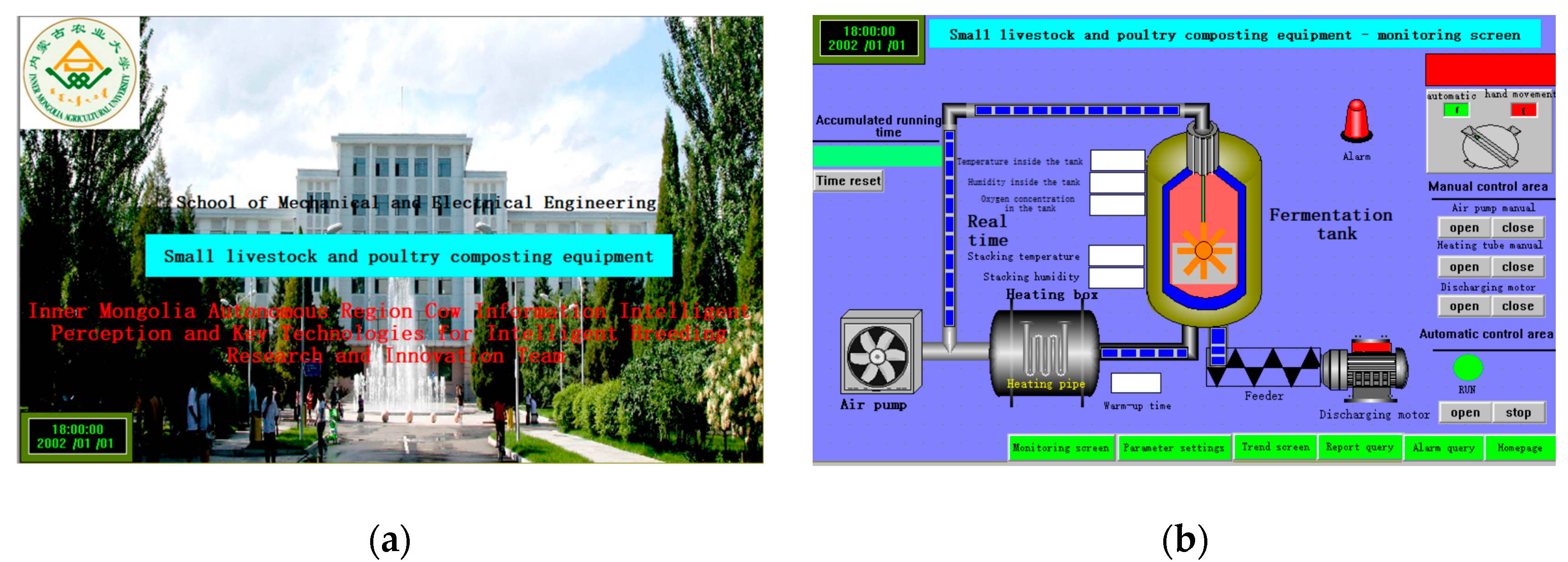
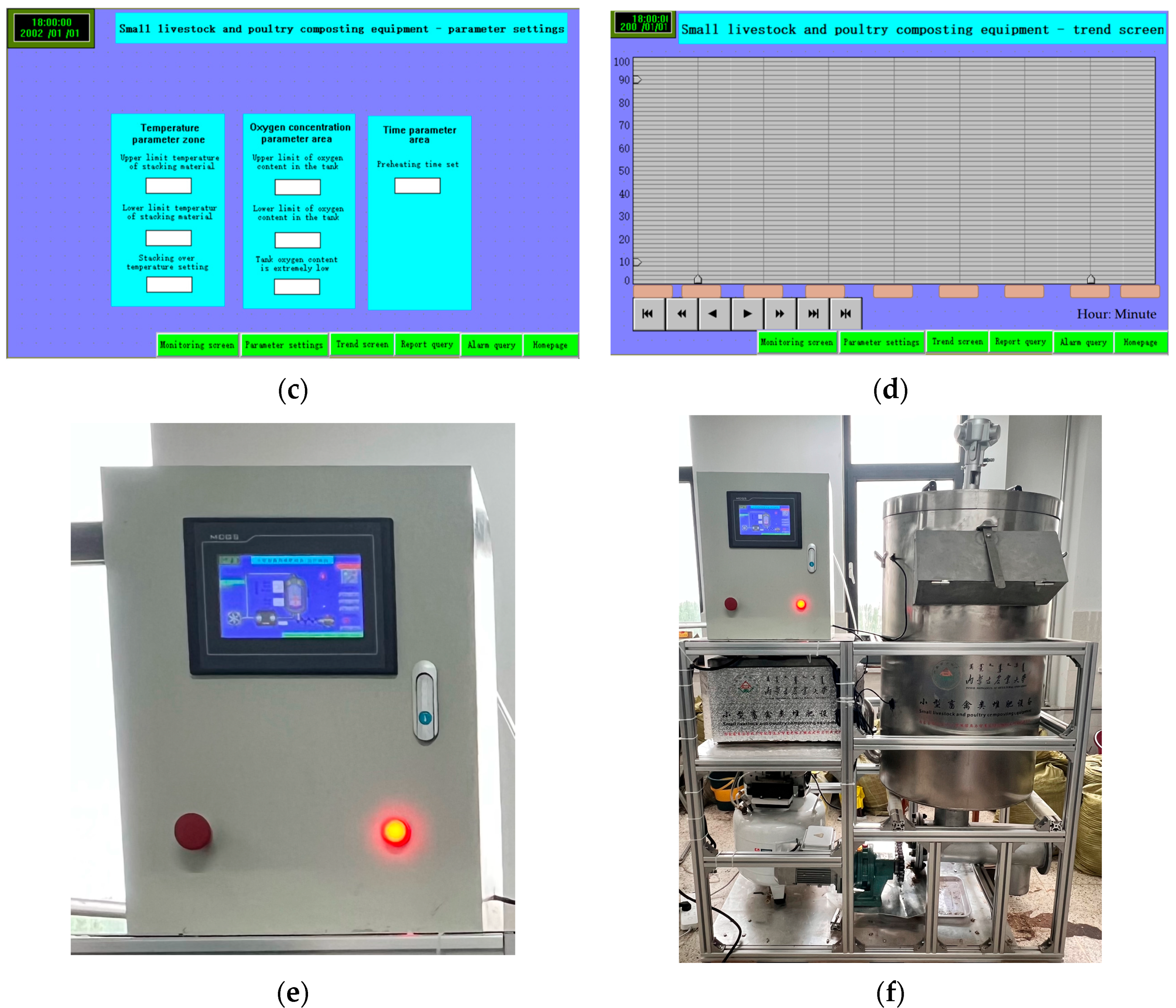
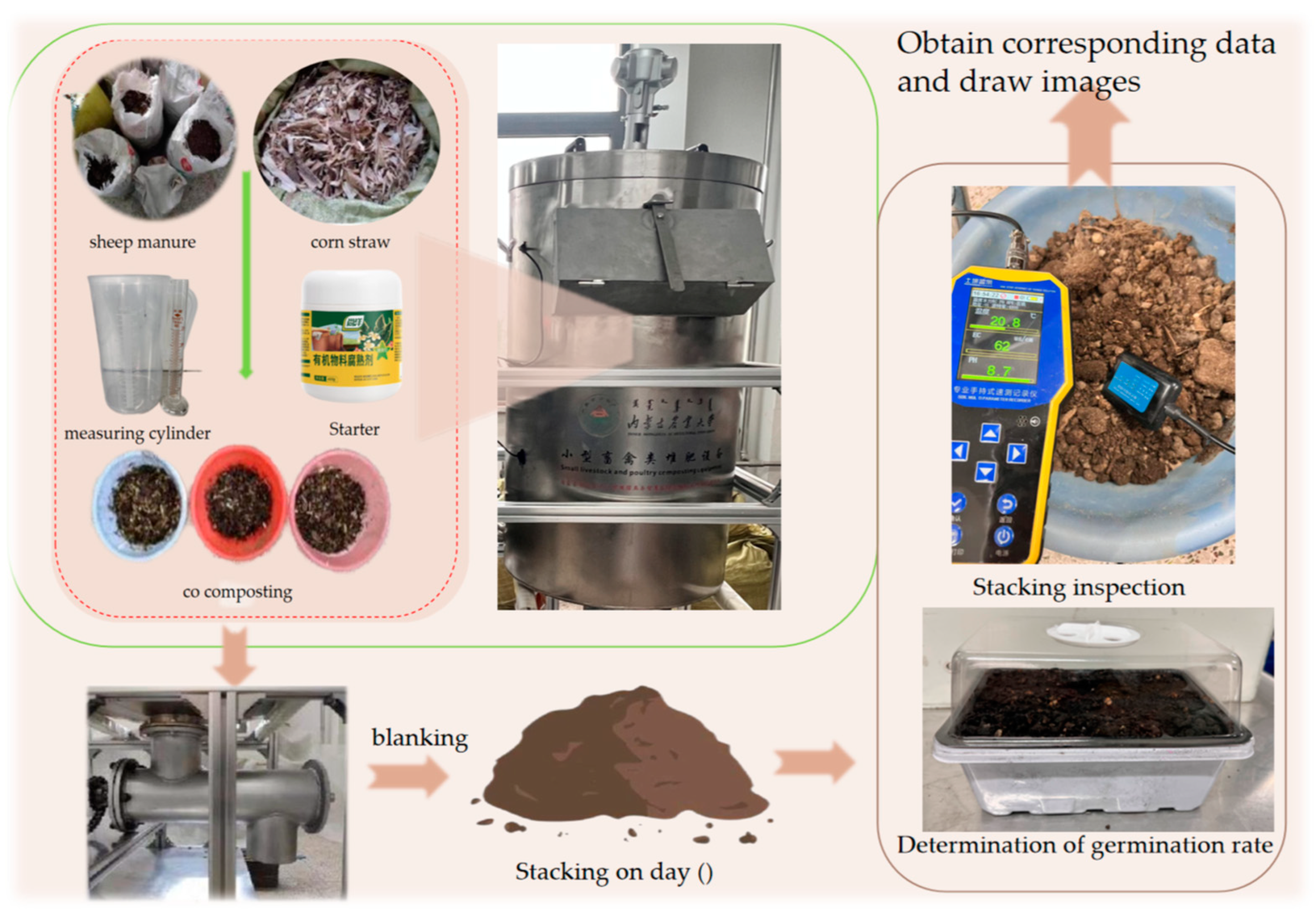
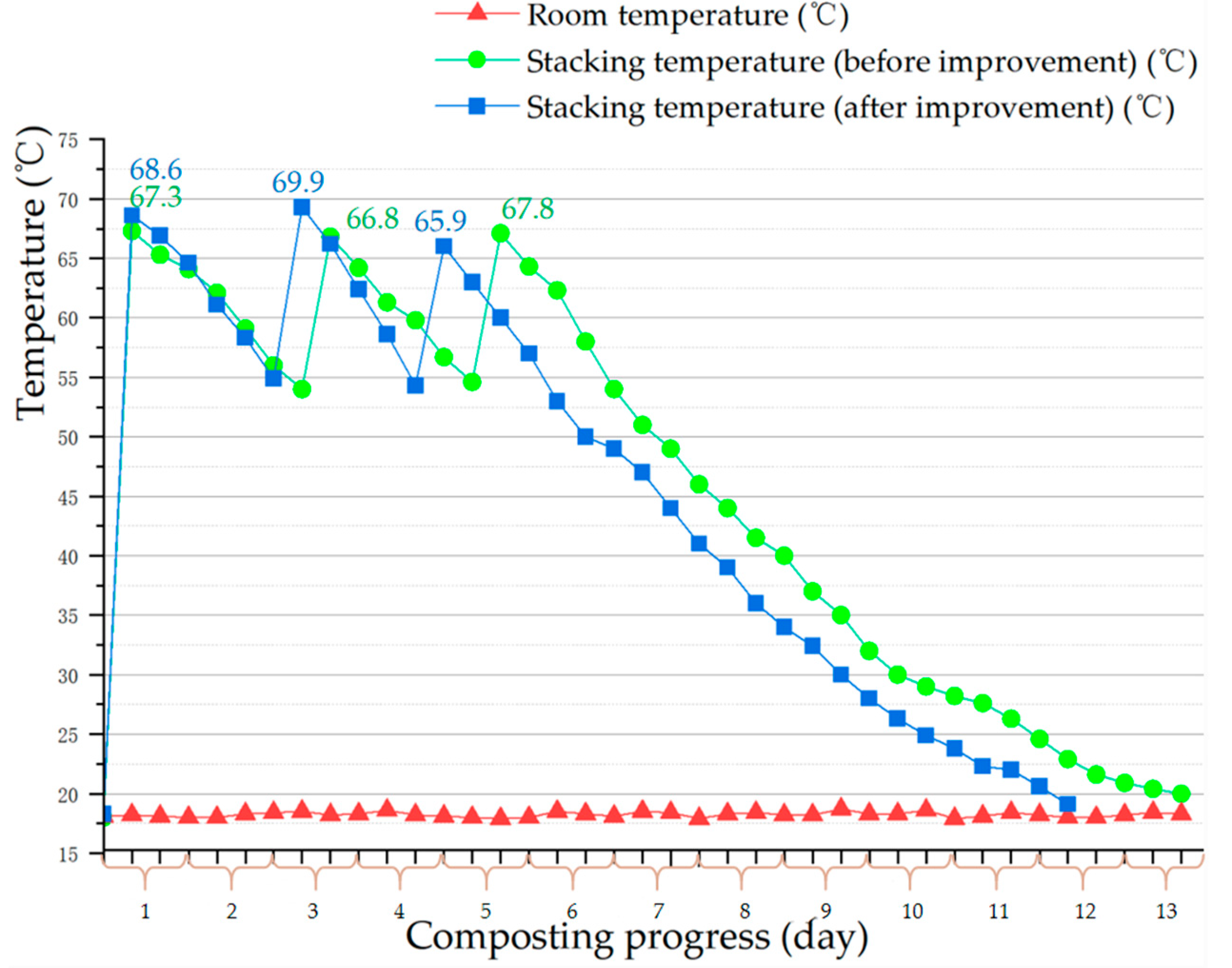
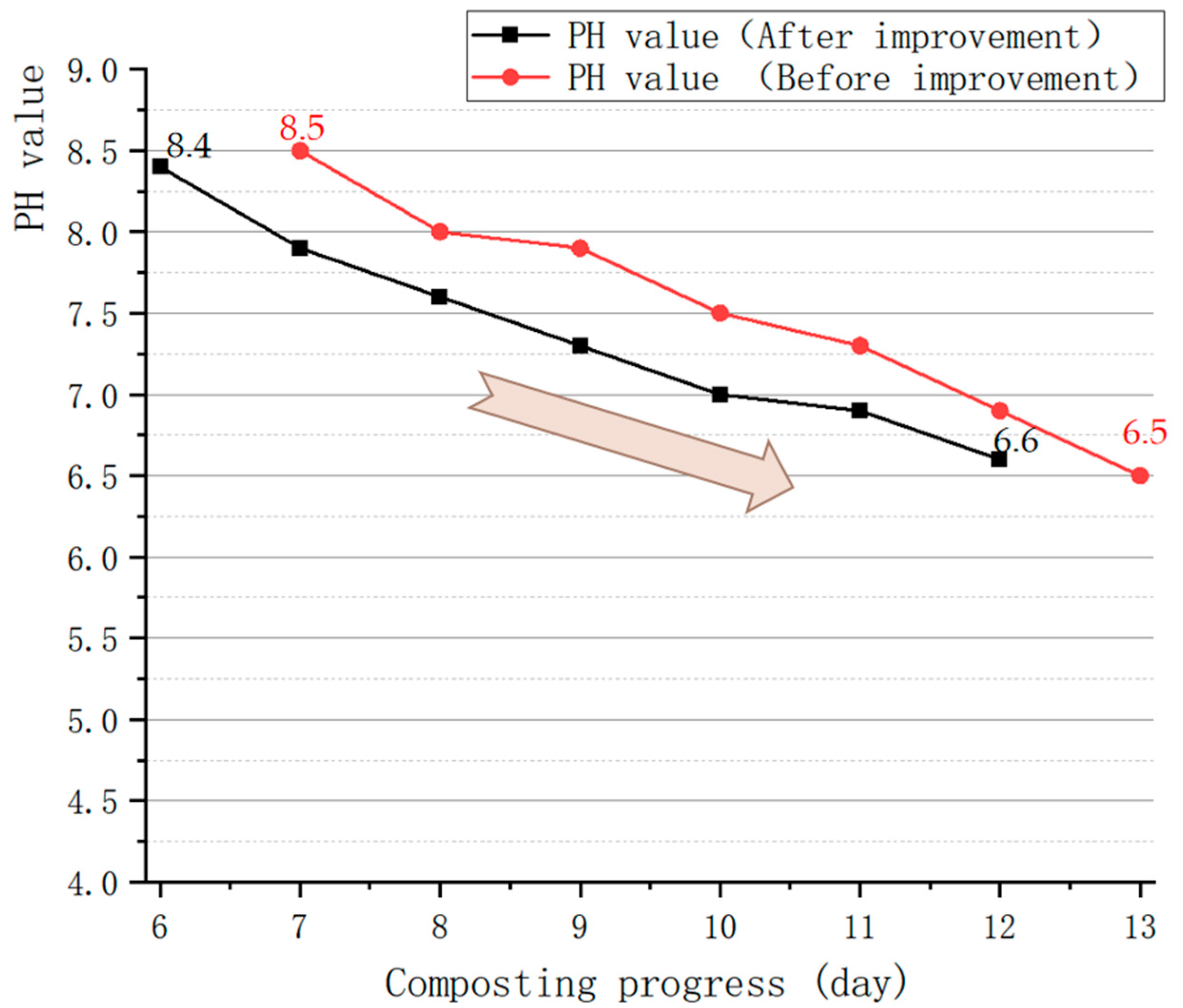

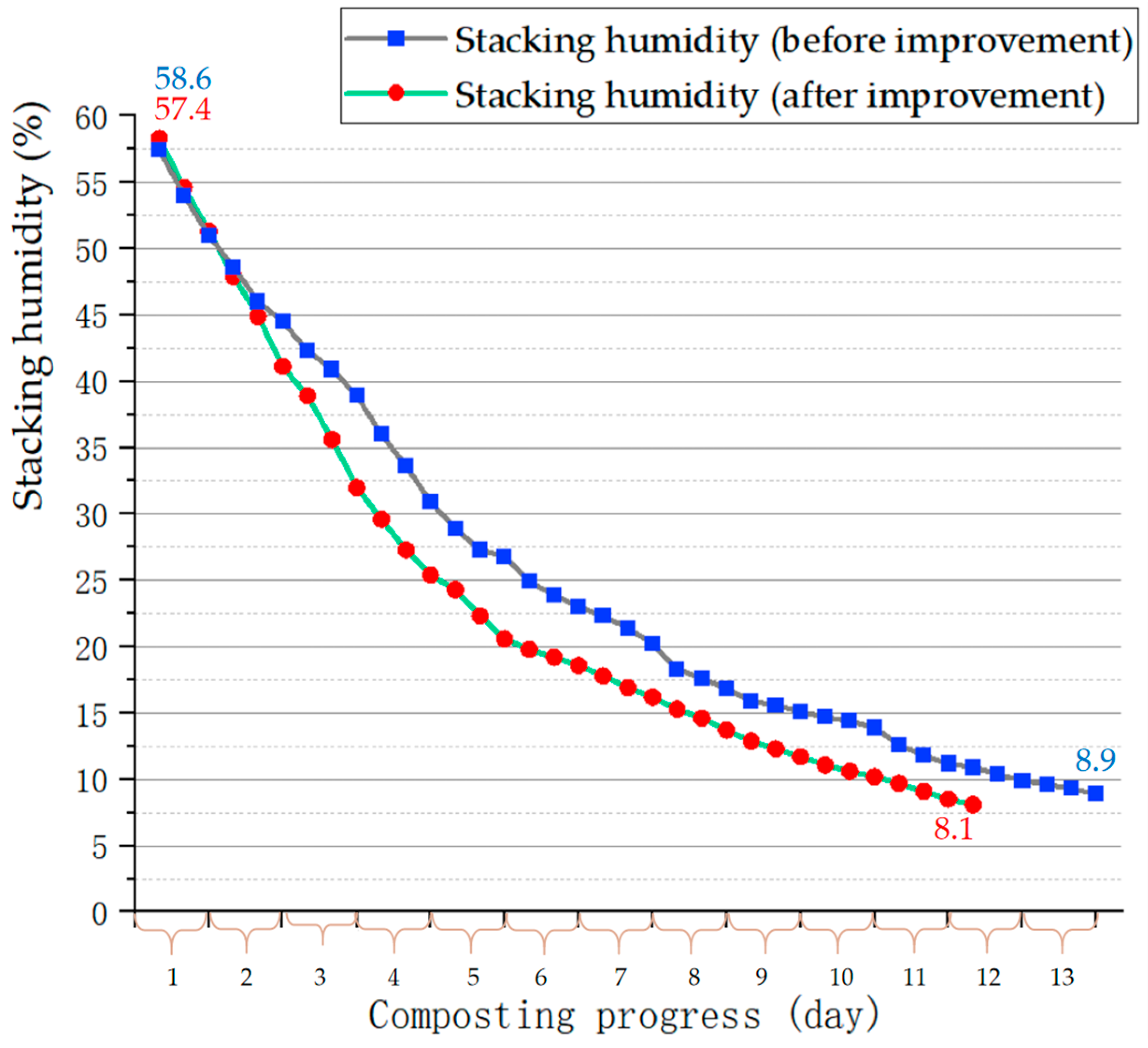
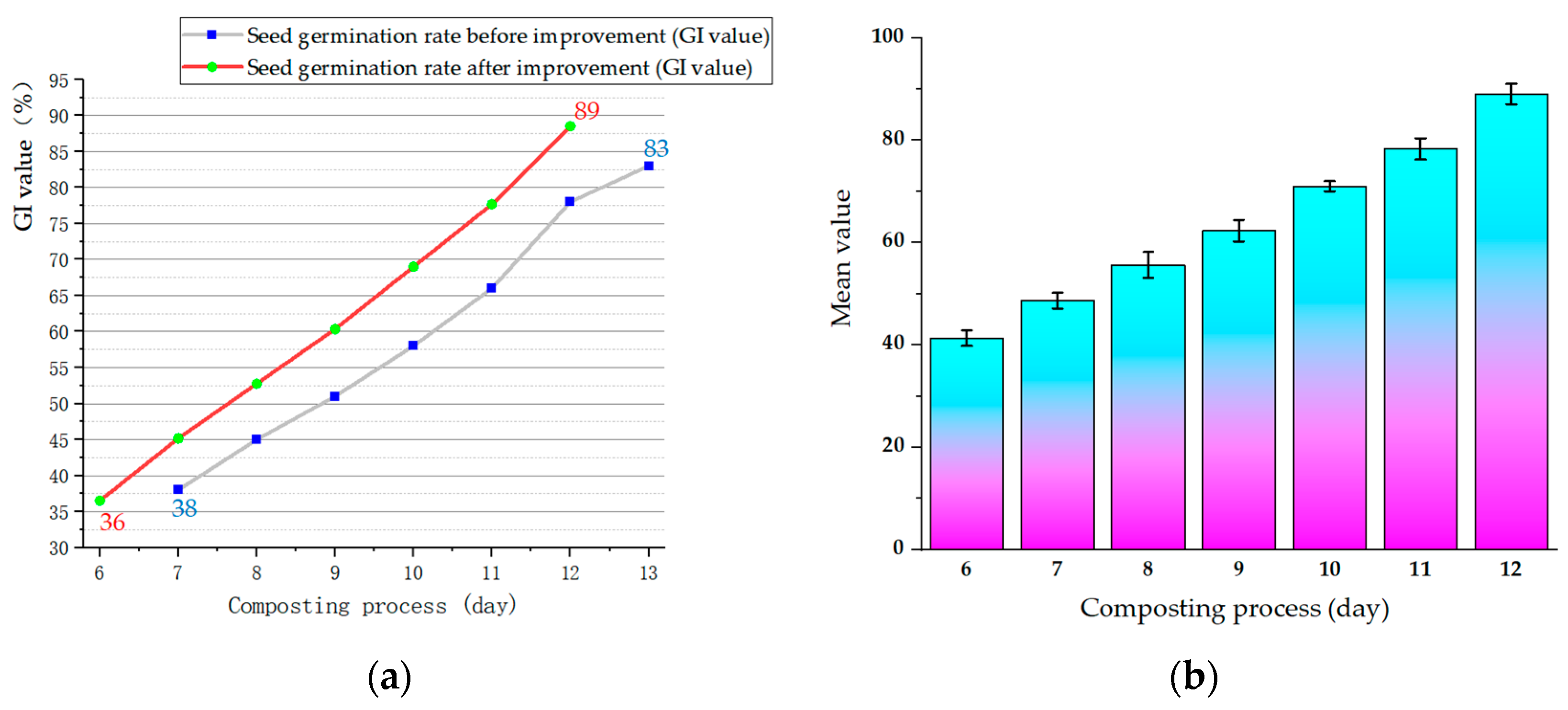
| Serial Number | Name | Function |
|---|---|---|
| 1 | Electronic scale | Weigh sheep manure |
| 2 | Activated carbon | Adsorption waste |
| 3 | Seedling tray | Planting mung beans |
| 4 | Farmland soil | Mixed fermented compost for mung bean cultivation |
| 5 | Mung bean | Measuring germination rate |
| 6 | Starter and glass measuring cylinder | Promote compost maturity |
| 7 | Soil detector | Detecting factors such as moisture content, pH value, and conductivity of compost |
| 8 | barrel | Mix compost amount and moisture content |
| Serial Number | Test Parameters | Unimproved Equipment | Improved Equipment |
|---|---|---|---|
| 1 | Composting cycle | 13 days | 11 and a half days |
| 2 | High-temperature maintenance time | 8 days | 7 days |
| 3 | Maximum temperature of stacking material | 67.8 °C | 69.9 °C |
| 4 | Minimum humidity of stacking material | 8.9% | 8.1% |
| 5 | Maximum Seed Germination Index (GI) | 83% | 89% |
| 6 | Minimum pH value | 6.5 | 6.6 |
| 7 | Minimum oxygen concentration | 14.8% | 15% |
Disclaimer/Publisher’s Note: The statements, opinions and data contained in all publications are solely those of the individual author(s) and contributor(s) and not of MDPI and/or the editor(s). MDPI and/or the editor(s) disclaim responsibility for any injury to people or property resulting from any ideas, methods, instructions or products referred to in the content. |
© 2023 by the authors. Licensee MDPI, Basel, Switzerland. This article is an open access article distributed under the terms and conditions of the Creative Commons Attribution (CC BY) license (https://creativecommons.org/licenses/by/4.0/).
Share and Cite
Ren, K.; Su, L.; Zhang, Y.; He, X.; Cai, X. Optimization and Experiment of Livestock and Poultry Manure Composting Equipment with Vented Heating. Sustainability 2023, 15, 11353. https://doi.org/10.3390/su151411353
Ren K, Su L, Zhang Y, He X, Cai X. Optimization and Experiment of Livestock and Poultry Manure Composting Equipment with Vented Heating. Sustainability. 2023; 15(14):11353. https://doi.org/10.3390/su151411353
Chicago/Turabian StyleRen, Kailin, Lide Su, Yong Zhang, Xiang He, and Xuyang Cai. 2023. "Optimization and Experiment of Livestock and Poultry Manure Composting Equipment with Vented Heating" Sustainability 15, no. 14: 11353. https://doi.org/10.3390/su151411353
APA StyleRen, K., Su, L., Zhang, Y., He, X., & Cai, X. (2023). Optimization and Experiment of Livestock and Poultry Manure Composting Equipment with Vented Heating. Sustainability, 15(14), 11353. https://doi.org/10.3390/su151411353








